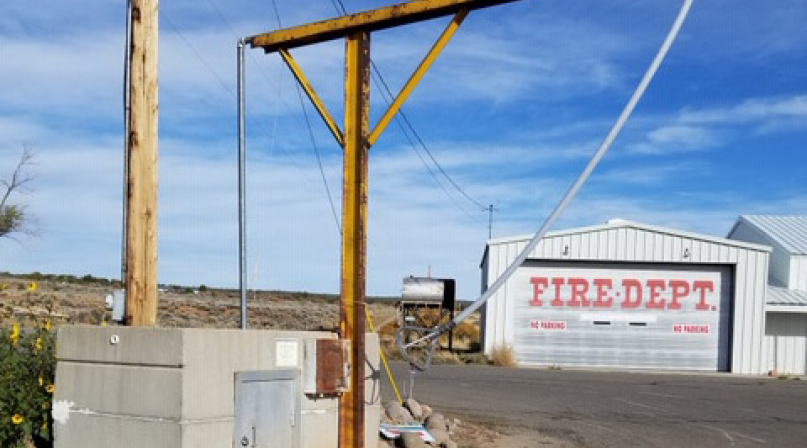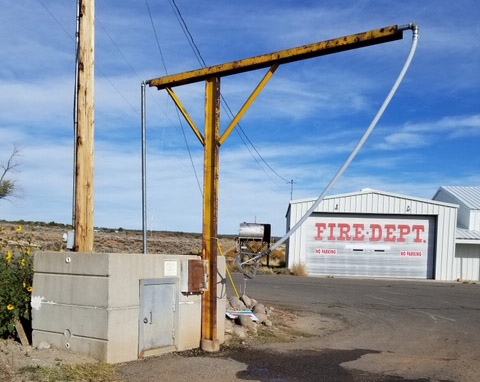‘Middle mile’ funding prospects vary for rural counties

Western San Miguel County, Colo. has gotten along for a while with its water dock system in the town of Egnar.
Without a useful aquifer, this retrofitted gas station tank is how everyone — residents, farmers, the volunteer fire department on the far western side of the state — gets what they need. If they’re lucky, people don’t lose their keys, their keys don’t break, and the one person who can repair the system, now nearing 80, will be around to help with any problems that might arise.
What the county really wants is to computerize the system, which will address a lot of those problems and allow more users to access the water, which is now limited by the number of physical keys. But without high speed internet to run it, that wouldn’t do much good.
“We’ve really gotten into a precarious situation,” said County Manager Mike Bordogna. “It’s a life safety issue, because people need water to live, and if there’s a fire, the volunteer firefighters are going to need to get it somewhere.”
In 2019, one user drove off with the valve still hooked up to his truck, leading the tank to “hemorrhage” water for four days before someone noticed and fixed it.
“That’s the kind of thing that an upgraded system would tell us immediately,” Bordogna said. “It could monitor for leaks and tell someone to go check it out.”
The lifesaving applications for broadband internet in western San Miguel County don’t end with water. In 2018, the county’s emergency dispatch went out of service four times because of connectivity issues, and the county’s mountainous topography doesn’t leave much room for rights of way along cliffside roads.
Low population density is the greatest impediment for rural counties seeking affordable broadband connectivity because the infrastructure costs per customer are so much higher over long distances. But San Miguel County, along with neighboring Dolores and Montezuma counties, could see some help coming their way, following a $6.3 million grant from the U.S. Department of Agriculture’s ReConnect program that will provide “middle-mile” fiber to bring infrastructure closer to rural communities.
“This could be a big deal for us,” Bordogna said. “(The internet service provider) talked about their products with 100mb and 1GB service, at modest pricing due to the USDA grants, which are faster than most of the affluent east end of our county enjoys for internet service. This will be a game changer when it happens.”
The internet service provider that won the grant plans to get to Egnar in four or five years, so Bordogna hopes the town can keep its current water system going that long.
The overall program has allocated $550 million in a combination of grants, low-interest loans and a blend of each nationwide for expanding high speed internet access. The first round of ReConnect funding awarded nearly $700 million to 79 different entities.
The three counties in Colorado will be served by a $6.3 million grant to a local telecommunications provider. That provider will deploy a fiber-to-the-premises network to connect 1,638 people, 91 farms, 52 businesses, three fire stations and two post offices.
None of them, however, is located in Montezuma County, in the state’s southwest corner.
“It won’t make it far enough for us,” said Jim McClain, Montezuma County’s IT director, noting that the funding will just be enough to get it to Dolores County, where the provider’s jurisdiction will end.
A 2017 engineering study found that supplying high speed internet to every house in Montezuma County could cost $39 million.
“Obviously we can’t do that, but it shows how expensive providing service like that can be,” he said.
McClain commissioned that study as he started to notice the digital divide separating Montezuma County from the rest of the state.
“There’s a huge need, and it’s preventing people from exploring our county as a new home,” he said. “Once you get five miles away from Cortez (the county seat), you’re going to be dealing with speeds that aren’t any better than dial-up.”
If 2016 showed the digital divide ahead of McClain on a map, the COVID-19 pandemic was the moment he drove off the cliff like Thelma and Louise (or Wile E. Coyote).
“Once we started sending people home and 80 percent of the 120 people live outside of the city, then we saw how much a problem this was,” he said. “They just can’t do their work at home with internet speed like this, and that doesn’t even figure in the kids trying to do schoolwork.”
McClain has tried to fashion internet hotspots, but the demand was so high, county employees might as well come back into the office.
“The way to accomplish this is as a public private partnership,” he said. “To have the county subsidizing and get some provider to step up and help, acquire the right of ways.”
ReConnect pays the provider to do a lot of that work, but it may come to counties to pitch in to keep it coming.
Access to reliable, high-speed broadband is essential for continued economic growth,” said Sallie Clark, who serves as the state director for USDA Rural Development Colorado and is a past NACo president and El Paso County commissioner.
“With the increasing use of telecommunication tools, good connectivity is vital for rural businesses, schools and health care facilities as they depend on reliable telecommunication systems to create and maintain jobs and provide necessary services to both residents and visitors,” she said. “This grant will not only assist residents in the counties served but will provide many positive spillover effects for the communities in the area.”
In Dolores County, Commission Chair Julie Kibel was pleased to hear that Emery, a Utah-based service provider, would do the work. The company’s familiarity with the geology figured to make it more reliable, after an eastern Colorado company’s work ended a mile short of the county seat of Dove Creek when it ran out of money.
“They were used to working in the clay soil in eastern Colorado, but the rocks out here were a lot tougher for them to work with,” she said. “The county ended up picking up that last mile.”
The prospect of expanded broadband access, and the size of the grant, excited her.
“That is what secures the dreams, when the funding is actually available,” she said. “Seeing the number of homes and businesses and post offices that will be connected was really encouraging. We have a lot of canyons, mountains and dead spots and this is just really going to open a lot of availability up to our constituents.”
Kibel said the pandemic has drawn some Dolores County natives home from Denver, and the promise of broadband could be enough to keep them here permanently.
“We’re still a frontier community, but it would be nice to have modern technology that advances life and lifestyles,” she said. “People like them coming home end up doing things like coaching sports teams and getting even more involved with the community.
“People like that settling here can give our community life.”

Attachments
Related News

Senators introduce bipartisan UPGRADE Act to support small and rural public water systems
On December 15, Sens. Lisa Blunt Rochester (D-Del.) and Roger Wicker (R-Miss.) introduced the Unincorporated Partnerships for Grant Resources, Assistance, and Drinking Water Enhancements (UPGRADE) Act (S. 3465), a bipartisan bill that would strengthen federal support for small public water systems and helps unincorporated communities access clean and affordable water.

House reintroduces bipartisan legislation to level playing field for rural communities
House reintroduced the Rural Partnership and Prosperity Act, bipartisan legislation intended to advance economic development in rural counties and overcome barriers to obtaining federal funding and resources.

